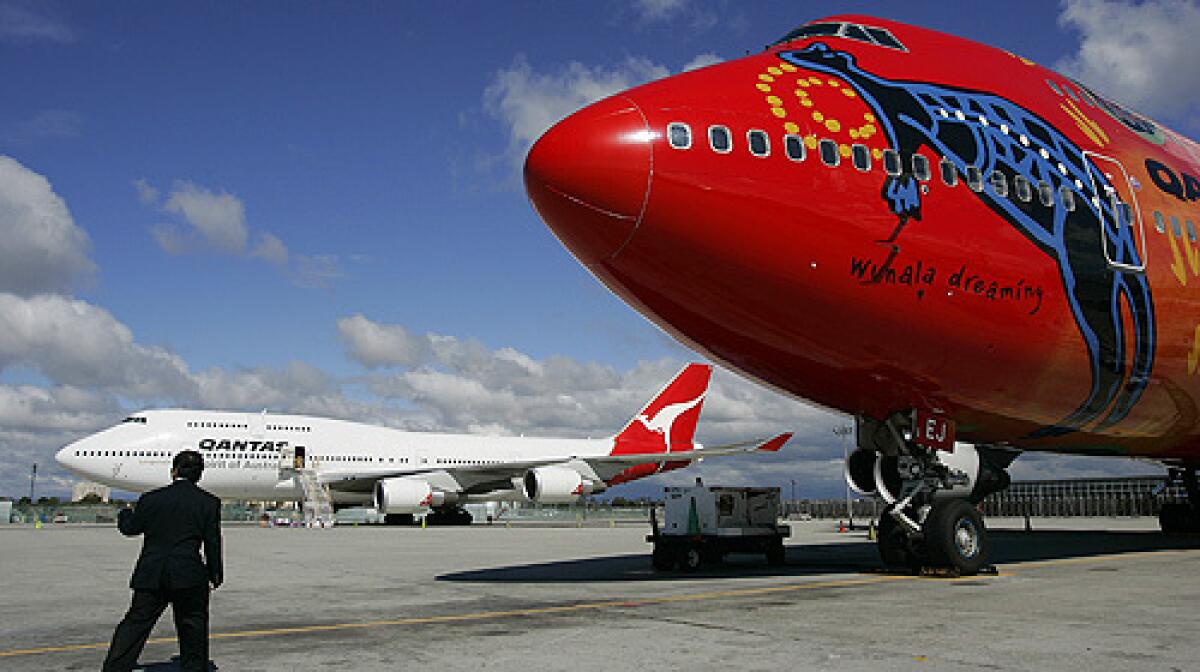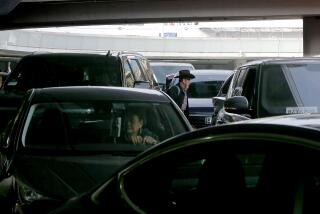LAX-to- Australia airfares may fall

G’Day travelers, air fares to Down Under are on their way down.
Travel between Sydney, Australia, and Los Angeles, considered one of the more popular but most expensive routes in the world, may be soon be getting more competitive for airlines and cheaper for passengers.
After a decade of wrangling, Australian and U.S. negotiators agreed to a landmark aviation pact to open their skies to each other’s airlines, and Los Angeles International Airport may become the big winner. It is the nation’s busiest hub for flights to and from Australia.
The deal, which must be ratified by both governments, would open the route to more airlines, including a fare-slashing carrier started by British billionaire Richard Branson.
Some analysts predicted that fares, currently hovering at $1,500 for the cheapest round-trip coach ticket between Los Angeles and Sydney could fall below $1,000 -- in line with other international flights of similar distances.
Corporate travelers buying business-class tickets for as much as $18,000 could see fares fall even further, perhaps by as much as several thousand dollars.
“It’s great news for consumers and the travel industry,” said Diane Embree, a travel consultant for Michael’s Travel Centre in Westlake Village. “A lot of people want to go to Australia, but because there is limited competition airlines have been able to charge whatever they want.”
LAX is expected to be a major beneficiary of the Open Skies Agreement, which was hammered out over three days in Washington.
The agreement “begins a new era where American and Australian consumers, airlines and economies can enjoy the benefits of lower fares and more convenient service,” U.S. Transportation Secretary Mary E. Peters said.
In an unusual duopoly, only two airlines have been allowed to offer nonstop flights between the two countries. And because of the demand for travel between the two countries, Australia’s Qantas Airways Ltd. is now the largest foreign-based carrier at LAX, operating three flights a day with 747 jumbo jets that often have full passenger loads.
Last year, it flew more than 1.2 million passengers between LAX and Australia, now considered one of the most profitable routes in the world. While the U.S.-Australia flights account for only a fraction of overall operations, they generated about 15% of the airline’s profit.
United Airlines, a unit of Chicago-based UAL Corp., is the only other airline that has been allowed to offer nonstop flights between the two countries. It has one LAX-Sydney flight a day.
“This is huge,” said Paul Haney, deputy executive director for LAX. “This deal is long-awaited and is likely to have a significant effect on our market.”
Indeed. In an interview earlier this week, Branson said his low-cost airline in Australia, Virgin Blue, already has applied to fly between Sydney and LAX, launching the first volley in what is expected to be an intense fare war. The transpacific route, to be operated by Virgin Blue’s new subsidiary V Australia, could begin as early as mid-October.
“It’ll bring a little bit of competition to that market place,” Branson said during a flight on Virgin America, his new U.S. airline that has helped drive down fares between LAX and such cities as San Francisco and New York. The airline shook up the industry by offering fares as low as $44 for flights from LAX to San Francisco and $139 for one-way LAX-New York tickets.
The agreement also could help increase chances of LAX becoming a hub for Branson’s ambitions to form a global carrier. LAX officials have been talking to both Virgin America and Virgin Blue to co-locate gates. Branson’s Virgin Atlantic, which flies transatlantic flights between London and LAX, would be next door.
With all three airlines adjacent to one another, passengers from both sides of the globe could connect at LAX to destinations in the U.S.
Such a move could provide an economic boon for the region, said Jack Kyser, chief economist for the Los Angeles Economic Development Corp. The research firm estimates that adding just one daily international flight at LAX could pump $623 million into the economy annually.
“It’s a big impact,” Kyser said.
But U.S. carriers are not expected to enter the fray, at least for now. Several airlines declined to say whether they would start an Australian route, but analysts said the airlines were likely to balk at the moment because fewer U.S. travelers are flying overseas amid a weak dollar and a slowing domestic economy.
Still, business travelers lauded the agreement.
“Good prices, competitive prices are important. It’s not a cheap flight, so any reduction in costs would certainly encourage more tourists,” said Adrian MacMillan, 35, an employee of an Australian energy company based in Southern California.
Chris McGinnis, a travel consultant for Travel Skills Group, said that because of Qantas’ dominance in nonstop flights between the countries, business travelers have been particularly hard hit. Round-trip business-class tickets range from $15,000 to $18,000, which McGinnis described as “extraordinary.”
“They had the highest business-class fares in the world.” McGinnis said. “The opportunity is there for someone to come in and really challenge Qantas on that.”
Times staff writer Marc Lifsher contributed to this report.
More to Read
Sign up for The Wild
We’ll help you find the best places to hike, bike and run, as well as the perfect silent spots for meditation and yoga.
You may occasionally receive promotional content from the Los Angeles Times.






